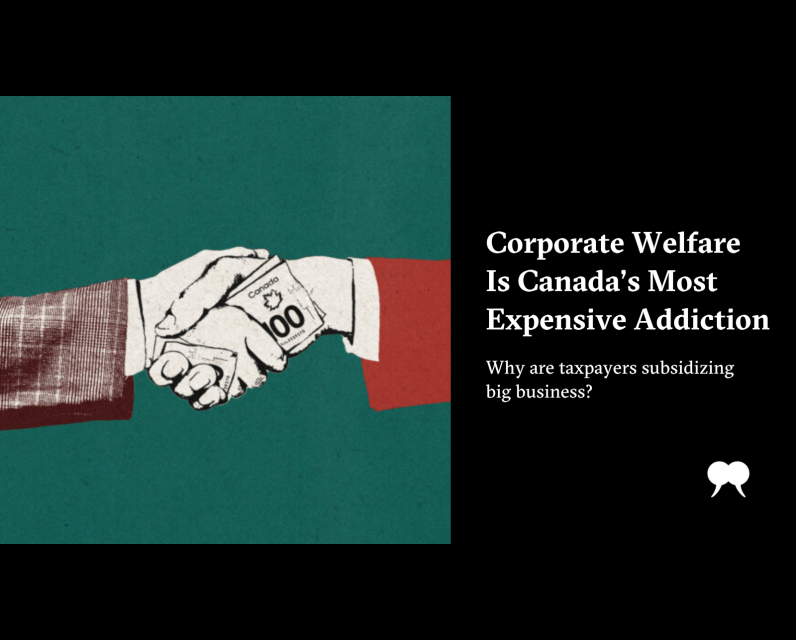Source Feed: Walrus
Author: Laurent Carbonneau
Publication Date: May 15, 2025 - 06:30
Corporate Welfare Is Canada’s Most Expensive Addiction
May 15, 2025

L et’s take a quick look at the busy fall 2022 schedule of then federal industry minister François-Philippe Champagne. His department, which has had many names but is now called Innovation, Science and Economic Development, or ISED, has been a major player in the subsidies business since its creation.
In mid-October, Champagne joined then prime minister Justin Trudeau in Sorel, Quebec, for a press conference with global mining giant Rio Tinto. They announced that the federal government would contribute $222 million to efforts to make the company’s local titanium and scandium processing plant more environmentally friendly. This funding was pitched as a key initiative of the federal government’s push to establish a homegrown electric car battery industry.
A few days later, Champagne, the prime minister, and Ontario premier Doug Ford hit a stage with senior officials of Finnish telecommunications giant Nokia in suburban Ottawa to announce that the federal, provincial, and municipal governments would contribute $72 million between them to the company’s planned expansion in the national capital.
In early November, Champagne was in Edmonton with his federal colleagues and counterparts from the provincial United Conservative government to unveil $300 million in federal support for a $1.6 billion investment by Air Products Canada in a hydrogen production facility in Alberta’s capital.
In just under a month, the federal government had announced, in partnership with two often hostile provincial conservative governments, just over half a billion dollars in funding for large projects by established companies, two of them arguably global household names.
It was a big fall for the innovation minister, big companies, and big cheques. But it was hardly the only largesse distributed by the federal government in 2022. Canada’s small businesses had been promised $4 billion in grants and loans through ISED and the Business Development Bank of Canada—BDC—in March to help get their products and services online. This was the new Canada Digital Adoption Program.
Hundreds of subsidies, incentives, and supports for private businesses, large and small, foreign and domestic, were announced by the federal and provincial governments in 2022. And it was only a few months into 2023 when Trudeau’s government announced the unprecedented package of handouts to automakers Volkswagen and Stellantis. Things have continued apace from there. The Strategic Innovation Fund, a support program for big, technology-intensive projects, rolled out another $7.5 billion in announced funding through the rest of 2023, and billions in clean manufacturing tax credits came online in spring of 2024.
If you ask staffers or ministers in the Trudeau government to name the one achievement in which they take the most pride, many will point to the Canada Child Benefit, or CCB, created soon after they formed government in 2015. I don’t blame them. The program has taken 300,000 children out of poverty. The benefit was expected to cost $26 billion in 2022, a substantial chunk of change. Yet, in 2023, the cost of the CCB was outweighed by the mass of subsidies, tax incentives, and preferential access to capital on offer from the government to corporations. Would many proud Liberals put the renaissance of the corporate welfare state at the top of their list of accomplishments?
T he first thing to understand about the past decade or so of subsidies is that they have exploded in magnitude. To present this as accurately and completely as possible, I’m hewing close to the methodology used by a former Department of Finance official, John Lester, in a 2018 paper that totalled federal and provincial subsidies as they existed in 2014/15. Lester defines business subsidies as all support to business with an economic outcome in mind, excluding supports that have social welfare, promotion of culture, or other goals as their primary objective. (That’s not to say that many of these excluded subsidies don’t make their way to corporate coffers: film and television production got $360 million worth of federal tax credits in 2023, and the federal government transferred a further $190 million through the Canada Media Fund.)
Leaving out measures intended to reduce carbon (and other greenhouse gas) emissions was, I think, a defensible position in Canada in 2014/15. In the age of green industrial policy, I think it is a bit of a tougher sell. I’ve chosen, nevertheless, to keep them out of my math here. Similarly, we’ll leave out pandemic support programs, which would completely dwarf and render irrelevant any pre-pandemic comparative data.
Totalling up program spending, implicit subsidies through Crown corporations, and tax credits and deductions, Lester found that in 2014/15, the last full year of Stephen Harper’s Conservative government, the federal government doled out $14 billion in subsidies to business. That works out to $390 for every person in Canada.
Starting in 2017/18, we can observe rapid growth in these figures. From 2015 to 2018, the Liberals added $3.3 billion to federal business subsidies. They more than matched that over the course of the next year, with $3.6 billion more in new money. In 2019/20, subsidies grew again by $2.5 billion, followed by another increase of $2.5 billion in 2020/21 and another of $1.8 billion in 2021/22. More recent estimates are even higher.
The long story short is that in nine years, over the lifetime of the Trudeau government, federal subsidies to business more than doubled through the introduction of over 100 new programs. Every Canadian went from paying just over $310 to businesses large and small to over $800 per year in 2023/24.
As mentioned, this does not include two important families of subsidies: measures intended to reduce businesses’ carbon emissions or those that were intended to support business through the pandemic. Adding numbers from climate-related business policies to our annual tally makes them bulge noticeably, up to $40 billion in 2023/24, or $1,007 for each Canadian. And as more announced measures of all kinds come online, subsidies will reach $50 billion every year by 2027/28. Assuming no more get announced between now and then is, of course, a fairly unlikely scenario.
If climate-related programs make the numbers bulge, the COVID-19 support programs take them right off the charts. The Canada Emergency Wage Subsidy—CEWS—alone doled out $100 billion from March 2020 to October 2021, or $20 billion more than the Canada Emergency Response Benefit—CERB. The other flagship business support through the pandemic, the Canada Emergency Business Account, or CEBA, approved $49 billion in interest-free loans, of which about 75 percent was paid back as of the final deadline in January 2024. Of course, it’s hard to begrudge the pandemic measures. The circumstances were unprecedented, these programs were one-offs, and avoiding a massive wave of bankruptcies and layoffs has so far kept Canada out of a bruising post-pandemic depression. No one thought in 2020 that 2023’s biggest problem would be that the economy would be too hot.
You might expect that, with all this support, Canada has roared to the top of those rankings of global indicators of productivity and economic success, or at least caught up to Italy. But no. Our economic performance is worse. We have warning lights popping up around all of our important indicators. Productivity, or the amount of output for every hour worked, has actually declined since 2018.
Worse, while we’ve been shovelling money at corporations, our social services have declined. There are 2 million more Canadians living without a family doctor than there were in 2019. Housing has become wildly unaffordable, with the Bank of Canada’s Housing Affordability Index reaching heights unseen since the excruciating double-digit interest rates of the early 1990s. And that marquee Liberal social program, universal access to subsidized child care spaces, is hitting bumps with staff shortages and long-term funding gaps that leave its future in doubt.
This is not a new problem. Canada has eagerly doled out public money hand over fist to businesses since the moment four colonies became one country in 1867, for reasons ranging from outright corruption to well-intentioned incompetence. The graft is interesting in a sordid way, but it is the century and a half of well-intentioned, supposedly strategic largesse that is the genuinely riveting story of corporate welfare in this country.
Whenever ministers arrive somewhere with a cheque, they are always proud to claim that this will be the “investment” that sets Canada on the path to the top of the league tables in important global indicators of productivity and economic success. And somehow, the country stubbornly lags behind its peers in the Global North. Italy is rightly regarded as a governance basket case, wracked by instability and sclerotic institutions. Yet, to take one indicator often seen as an important sign of economic dynamism, Italy recently passed Canada in rankings of business investment in research and development.
The question is obvious. How has Canada spent so much public money to achieve so little for so long?
T here are a range of views for and against the widespread practice of governments supporting business. Some decry any and all spending of this nature as unearned spoils and corporate welfare of the worst kind, reflecting the corruption of the pristine free market by the demagogic carnival barkers who invariably sit as our elected representatives. There is a left-wing mirror image of this view that maintains Canada is actually “three mining companies in a trench coat” who have captured our government and trained it to do their bidding.
Self-styled pragmatists maintain that government support for business is a competitive global sport that can be played well or badly, much like international soccer, never mind that it often looks more like the ugly bureaucratic and political machinations that surround international soccer. There is also the earnest view that while government support for business is usually misguided and misspent, the best tonic to these unearned windfalls for the rich is broader government involvement in the economy.
While I understand the frustration and respect both the crankiness and ideological purity of the first two groups, in the absence of the reasonable prospect of a socialist revolution tomorrow, I find my analysis ends up somewhere between the latter two camps. Canada’s reality is that as a small, open economy in a global capitalist system that prizes relatively free flows of investment across national borders, governments have to be smart in ensuring that capital flows end up benefiting the country, by raising productivity and building up wealth to allow for a generous and democratic social state. The long-run result of stagnation is to be a source of cheap labour and learning to live with the highly unequal political economy that comes with that.
The corporate welfare state—that policy apparatus of business subsidies Ottawa has built since Confederation—has not delivered on its stated objectives of promoting economic growth and social welfare. Nevertheless, it keeps growing, and, in fact, we’ve recently passed an important threshold. Since 2019/20, Canadians have been giving away more than fifty cents of every dollar collected in corporate income taxes right back to businesses.
Canadians are facing serious crises in critical public services like health care and child care and social goods like housing. Does it really make sense for us to give Canadian businesses back more than half of what they pay in taxes when so many people can’t find a family doctor or afford a home?
At the end of the day, any progressive government should see steady improvement of the quality of life of working people as its lodestar of legitimacy and political strength. Redistribution is part of that, but so is organizing for growth. Leaving Canada’s coddled corporate class to steer our economy in partnership with a government unable to resist giving it virtually everything it wants is no longer tenable.
To paraphrase David Lewis, the question is no longer whether we shall pursue industrial strategy or not. The question is whether we shall have it for monopoly by monopoly or build a state capable of planning by the people for the people. A richer country and a more capable state able to take on the big challenges of our time are possible.
Excerpted from At the Trough: The Rise and Rise of Canada’s Corporate Welfare Bums. Copyright © 2025 Laurent Carbonneau. Reprinted by permission of Sutherland House Books.The post Corporate Welfare Is Canada’s Most Expensive Addiction first appeared on The Walrus.
Although the suspect in a firearm discharge in Petawawa in March remains at large, the investigation of that incident has led this past week to the arrest of eight other individuals and the seizure of more than $2.5 million worth of illegal drugs, police say. Read More
June 7, 2025 - 19:45 | Gord Holder, Postmedia | Ottawa Citizen
Two pedestrians were transported to hospital with what the Ontario Provincial Police described as "minor and serious injuries" after they were struck by a pickup truck in Prescott on Saturday morning. Read More
June 7, 2025 - 18:57 | Gord Holder, Postmedia | Ottawa Citizen
Delaney Baie Pridham scored three goals to lead Ottawa Rapid FC to a 4-0 win over AFC Toronto in Northern Super League women's action Saturday.
June 7, 2025 - 18:12 | | CBC News - Ottawa



Comments
Be the first to comment